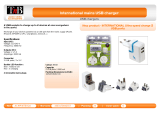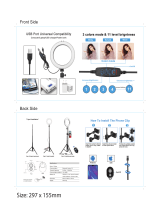Page is loading ...

Leica HDS6000
User Manual
Version 1.1
English

2HDS6000
Introduction
Introduction
Purchase Congratulations on the purchase of a HDS6000 instrument.
This manual contains important safety directions as well as instructions for setting
up the product and operating it. Refer to "6 Safety Directions" for further informa-
tion.
Read carefully through the User Manual before you switch on the product.
Product
identification
The type and the serial number of your product are indicated on the type plate.
Enter the model and serial number in your manual and always refer to this informa-
tion when you need to contact your agency or Leica Geosystems authorized service
workshop.
Type: _______________
Serial No.: _______________
Network Address: _______________
IP Address: _______________

Introduction HDS6000 3
Symbols The symbols used in this manual have the following meanings:
Trademarks • Windows is a registered trademark of Microsoft Corporation
• Bluetooth is a registered trademark of Bluetooth SIG, Inc
All other trademarks are the property of their respective owners.
Type Description
Danger Indicates an imminently hazardous situation which, if not
avoided, will result in death or serious injury.
Warning Indicates a potentially hazardous situation or an unintended
use which, if not avoided, could result in death or serious injury.
Caution Indicates a potentially hazardous situation or an unintended
use which, if not avoided, may result in minor or moderate
injury and/or appreciable material, financial and environmental
damage.
)
Important paragraphs which must be adhered to in practice as
they enable the product to be used in a technically correct and
efficient manner.

4HDS6000
Table of Contents
Table of Contents
In this manual Chapter Page
1 Description of the System 7
1.1 Instrument Components 7
1.2 Cabling 14
1.2.1 Operate the HDS6000 with the Battery 14
1.2.2 Operate the HDS6000 with the Battery Charger
(AC power supply) 20
1.2.3 Operate the HDS6000 with the External Battery 22
1.3 Field of View (FOV) 27
1.4 HDS
Cyclone
Software Suite 28
2 Setting Up the Instrument 31
2.1 General Information 31
2.2 Scanner Setup on Tripod 32
2.3 Setup the HDS6000 Over a Benchmark 34
2.4 Instrument Height 37
2.5 Setting Up the Instrument with the Dolly 38
3 Preparing to Scan 41
3.1 Switch On/Off the System 41
3.2 Preparations 42

Table of Contents HDS6000 5
3.3 Ambient Conditions 46
3.4 HDS6000 Controls 49
3.4.1 HDS6000 Control Buttons 49
3.4.2 Menu Control 50
3.5 Scanning 57
3.6 Data Management 63
3.7 Settings 64
3.8 Updating the Firmware 70
3.9 Connections 71
3.10 Network 72
3.10.1 Connecting the HDS6000 by Cable to the Network 73
3.10.2 Connecting the HDS6000 to a Notebook 75
3.11 Operating the HDS6000 using a Web Browser 77
3.12 HDS6000 and WLAN Connection 82
4 Troubleshooting 84
5 Care and Transport 87
5.1 Check & Adjust 87
5.2 Transport 88
5.3 Storage 89
5.4 Cleaning and Drying 90
5.5 Window Cleaning Procedure 91
5.6 Adjustment of the Circular Level 93
5.7 Service of the Tripod 95

6HDS6000
Table of Contents
6 Safety Directions 96
6.1 General Description 96
6.2 Intended Use 97
6.3 Limits of Use 99
6.4 Responsibilities 100
6.5 International Warranty, Software Licence Agreement 101
6.6 Hazards of Use 103
6.7 Laser Classification Scanner, Visible Laser 111
6.8 Electromagnetic Compatibility EMC 117
6.9 FCC Statement, Applicable in U.S. 120
7 Technical Data 126
7.1 General Technical Data of the Instrument 126
7.2 System Performance 127
7.3 Laser Scanning System 129
7.4 Electrical 132
7.5 Environmental 133
7.6 Physical 135
7.7 Accessories 135
7.8 WLAN 140
7.9 Conformity to National Regulations 141

Description of the System HDS6000 7
1 Description of the System
1.1 Instrument Components
Overall system
a) HDS6000
b) Rechargeable internal battery
("battery" will be used)
c) Tribach
d) Tripod
e) Cleaning kit
f) Carrying straps
g) Transport box for power supply
h) Transport box for HDS6000
i) Ethernet cable
j) HDS6000 power supply cable
k) Charging cable (optional)
l) Battery charger power cable
m) KNL-24 battery charger/AC power
supply
("battery charger" will be used)
n) Charging cradle
24V
6,3
AM
i
j
k
l
m
n
a
b
c
d
f
e
g
h
HDS6000_001

8HDS6000
Description of the System
Hardware options • External Battery TRAPP-15-24
• HDS6000 scan targets and target accessories
• Dolly
Transport box for
power supply
a) Battery charger
b) Battery
c) Charging cradle
d) Charging cable
e) Battery charger power
cable; three different types
delivered
f) Battery
24V
6,3 AM
HDS6000_007
d
e
a
b
c
f

Description of the System HDS6000 9
Transport box for
HDS6000
a) HDS6000
b) Manuals
c) Carrying straps
d) HDS6000 power supply
cable
e) Ethernet cable
HDS6000_007a
c
d
e
a
b

10HDS6000
Description of the System
HDS6000
a) Handle
b) Mirror (Laser exit)
c) Laser active light, flashes
while scanning
d) Circular level
e) Antenna
f) Display
g) USB Connectors, P1, P2
h) Lemo Connectors (not
supported), P3, P4
i) ON/OFF button
j) Keyboard
k) Ethernet connector
l) Connector for power
supply
a
b
c
e
d
g
h
j
k
l
i
f
HDS6000_002

Description of the System HDS6000 11
Battery and
charging cradle
)
Use the SupD-9 plug only for connecting to the battery.
a) Battery
b) Charging cradle
c) Battery status indicators
d) Connector for power supply
e) Power indicator LED
f) Error LED
g) SupD-9 plug; connects
battery and charging cradle
a
b
cdefg
HDS6000_003
ERR

12HDS6000
Description of the System
Battery charger
a) Air inlet
b) Mains switch
c) Fuse
d) Mains plug
e) Fan
f) Fuse
g) Green LED, showing battery
is fully charged
h) Yellow LED
i) Power indicator LED
j) Power output
HDS6000_066
24V
6,3 AM
a
b
c
d
f
g
h
i
j
e

Description of the System HDS6000 13
External battery
TRAPP-15-24
a) Main switch
b) Battery status indicators
c) Output additional voltage,
not used
d) Fuse for additional voltage,
3.15 AM
e) Main output
f) Fuse for main output,
6.3 AFF
HDS6000_067
b
a
e
f
d
c

14HDS6000
Description of the System
1.2 Cabling
1.2.1 Operate the HDS6000 with the Battery
Change the battery
)
A battery should always be attached to ensure the optimum weight balance for the
HDS6000.
1. Hold the battery with both
hands and press the fixing
clips.
2. Pull the battery carefully
downwards.
HDS6000_021
1
1
2

Description of the System HDS6000 15
)
Never remove the battery while the HDS6000 is switched on.
Precautions:
• Switch off the HDS6000 beforehand or
• use the external power supply
)
Primary use/charging
• The battery must be charged prior to using it for the first time because it is deliv-
ered with an energy content as low as possible.
• For new batteries or batteries that have been stored for a long time (> three
months), it is effectual to make only one charge/discharge cycle.
• For Li-Ion batteries, a single discharging and charging cycle is sufficient. We
recommend carrying out the process when the battery capacity indicated on the
charger or on a Leica Geosystems product deviates significantly from the actual
battery capacity available.
• The permissible temperature range for charging is between 0°C to 40°C / +32°F
to +104°F. For best results the recommended temperature range for charging is
between +10°C and +20°C.
• It is normal for the battery to become warm during charging. Using the chargers
recommended by Leica Geosystems, it is not possible to charge the battery if the
temperature is too high.

16HDS6000
Description of the System
Operation/Discharging
• The batteries can be operated from 0°C to 40°C / +32°F to °104°F.
• Low operating temperatures reduce the capacity that can be drawn; very high
operating temperatures reduce the service life of the battery.

Description of the System HDS6000 17
Charging the
battery
)
Charging of the battery takes approximately 1.5 hours.
1. Turn off the battery charger.
2. Plug the power cable into the battery charger
and into an A/C plug.
3. Using the charging cable connect the
charging cradle and the battery charger.
4. Place the battery onto the charging cradle.
5. Turn on the battery charger. Its power indi-
cator LED switches on.
6. After 30sec initialization, the charging
cradle’s battery status indicators will indicate
the current battery charging status.
7. After charging the battery, turn off the
battery charger.
8. Disconnect the cables.
HDS6000_004
2
4
V
6
,
3
A
M
2
2
3
3
4
ERR

18HDS6000
Description of the System
Understand the charging cradle’s LEDs:
a) Battery status indicators
b) Power indicator LED
c) Error LED
Battery status
indicators
• If all four LEDs flash continuously then there is no battery in
the charging cradle.
• The overall charging capacity of the battery is divided into
quarters. Each LED corresponds to a quarter:
• If the battery charge state is low the appropriate LED
flashes slowly.
• The LED flashes faster as the charge state improves.
• If an LED illuminates constantly the battery has reached
the appropriate level of charge.
• When all four LEDs illuminate constantly the battery is
100% charged.
HDS6000_006
a
b
c
ERR

Description of the System HDS6000 19
Danger To avoid electrical shock, outdoor use of the battery charger is not permitted.
Precautions:
Use the battery charger in dry indoor environments only.
Danger Death or serious injury can occur if product is not connected to ground.
Precautions:
To avoid electric shock power cable and power outlet must be grounded.
Error LED The red LED illuminates if there is a fault in the electricity supply.
Please refer to "HDS6000 Battery" in "4 Trouble-shooting".
Power indicator
LED
The green power indicator LED illuminates if the charging cradle
is under voltage.
Laite on liitettävä suojamaadoituskoskettimilla varustettuun
pistorasiaan.
Apparatet må tillkoples jordet stikkontakt.
Apparaten skall anslutas till jordat uttag.

20HDS6000
Description of the System
1.2.2 Operate the HDS6000 with the Battery Charger (AC power
supply)
Operate the
HDS6000 with the
battery charger
1. Verify that the battery charger is off.
2. Connect the battery charger power cable.
3. Connect the HDS6000 and the battery charger with the HDS6000 power supply
cable.
4. Turn on the battery charger.
a) HDS6000 power supply cable
b) Battery charger
c) Battery charger power cable
HDS6000_005
2
4
V
6
,
3
A
M
cba
/



